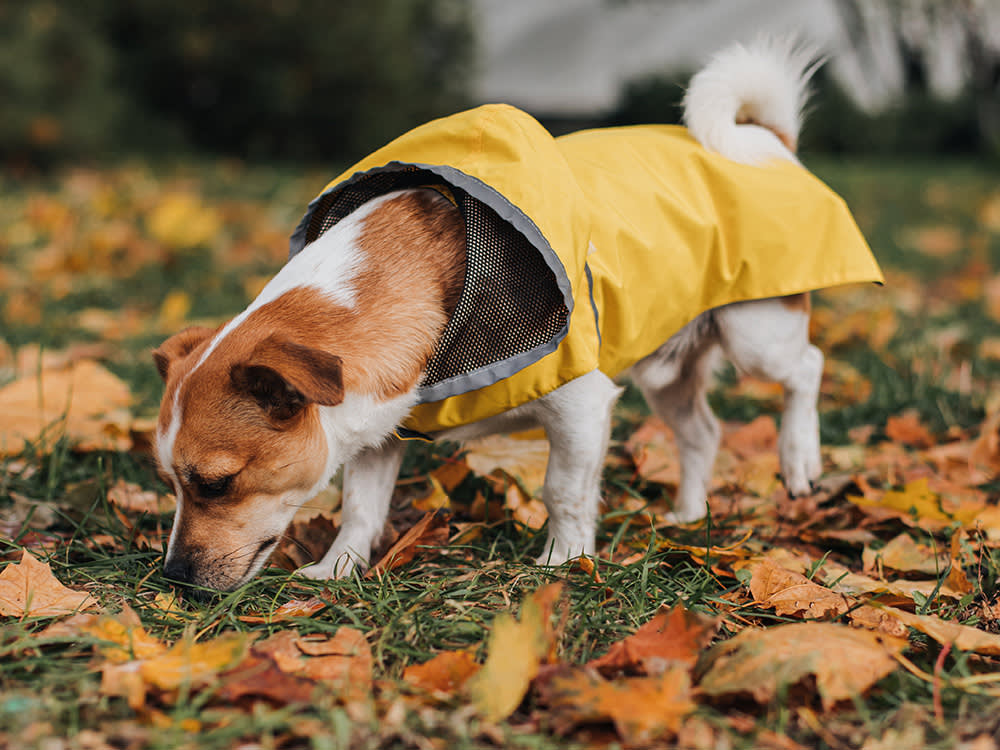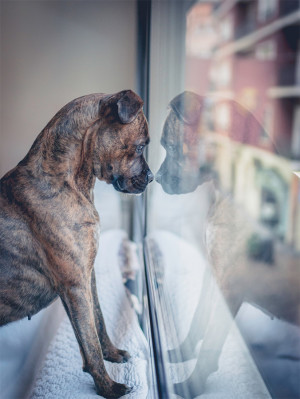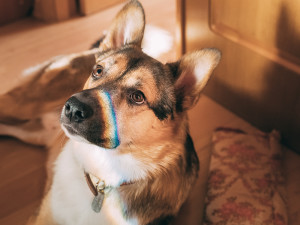What Can Your Dog Smell?
There’s a reason that sweet little nose is always pressed to the ground

Share Article
Dogs use their sense of smell to perceive the world in a way that is very different than we do. Dogs have a much larger olfactory bulb – which is responsible for processing smells – than humans. They can also use their sense of smell to detect bombs and drugs (remember, you cannot pet the pups in line at the airport, as much as you want to), and are often used in search-and-rescue operations because of their keen sense of smell.
Dogs use their sense of smell to create an image of their environment in a way that people do not. This allows them to be aware of territorial changes, locate sustenance (what dog doesn’t try to go after that rogue burger bun in the street?) and avoid dangers. Although much research has been done on dogs’ amazing sense of smell, scientists routinely find new odours that dogs can recognise, and are able to leverage dogs’ abilities to benefit medicine, protect endangered species and assist humans with medical conditions.
Anatomy of a dog’s nose
Understanding a dog’s smelling sense requires some knowledge of the difference between sniffing and smelling. Smelling is the unconscious processing of evaluating what’s in the air. No extra effort is needed for smelling, it just comes along as a part of breathing. Sniffing is the conscious act of scanning the environment for information by breathing in a rhythmic pattern through the nose.
Interestingly, most dogs have a right-sided preferenceopens in new tab when sniffing. They start sniffing through the right nostril and only switch to the left side if the smell is familiar or non-threatening. This is thought to happen because the right side of the brain handles the processing of new information, while the left side of the brain uses memory to determine how to respond appropriately to familiar scents.
Some basic anatomy is needed to understand how scents are processed after your dog inhales. A dog’s sense of smell is best understood by following the path of air as they breathe:
Nostrils: these are the visible openings through which air enters into the nose.
Nasal passages: after entering through the nostrils, air travels through the nasal passages, which help to warm and remove larger particles from it. Most of the air moves on to the pharynx (throat) then into the lungs, but about 12 percentopens in new tab of it goes into a deeper part of the nose that processes odours.
Olfactory epithelium: in the deeper part of the nose, the lining of airways changes to olfactory epithelium, which is made up of three different cell types. Olfactory receptor cells are the most important cell type for a dog’s sense of smell. These specialised neurons are activated when chemicals in the air bind to them. The number and variety of cells activated indicates the intensity and type of smell detected to the brain.
Olfactory nerve: the signals from the olfactory epithelium move along this nerve to reach the brain.
Olfactory bulb: this specialised region of the brain filters information from the outside world. It de-emphasises background odours and enhances sensitivity to new, interesting or threatening odours. From here, the info about the scents is sent to appropriate parts of the brain to see if it matches a remembered smell or triggers a conscious response.
Information from most other senses ‘crosses over’ before entering the brain. For example, touch to the right hand is processed by the left side of the brain first. Scent information does not cross over. It follows a straight path from the scent-detecting neurons on one side of the nose to the same side of the brain. Dogs’ right-nosed-ness (probably not a word, but whatever) is likely due to this. Reacting quickly and instinctively to scent information helps keep dogs safe from danger.
To further complicate things, dogs have something called the vomeronasal organ that is located above the roof of the mouth and beneath the nasal cavity. This specialised organ detects pheromones through small ducts behind a dog’s upper incisors. If you’ve ever seen a dog curling and lifting their upper lip when smelling something (especially a female dog’s urine), they’re making that funny face to open those ducts and allow more pheromones to reach the vomeronasal organ.
How far can a dog smell?
Dogs can smell things from quite far off, across both distance and time. In field trials, dogs have been shown to be able to smell whale faeces over a mile awayopens in new tab. That is a very specialised skill set, but it is likely very helpful to the people tracking the health of whales.
A dog’s ability to pick up a scent will depend greatly on local conditions. The direction of the wind is likely the biggest determining factor, but other environmental conditions like humidity, fog, rain and terrain play a role as well. Humidity helps carry scent particles into the nose, but rain can push smells closer to the ground and make it more challenging for dogs to track them.
Scent dogs, such as Bloodhounds, can trace a human’s path through a busy city up to 48 hours after the person has passed through the area. That means your dog may be figuring out what happened days ago when they fixate on an interesting scent while out for a walk.
How does a dog’s sense of smell compare to a human’s?
It’s hard to know exactly how much stronger a dog’s sense of smell is than a human’s. Dogs have more olfactory receptor cells than humans (100–300 million versus 5–6 million). In addition, their olfactory bulb (remember that?) is about three times larger than a human’s. But does all this extra processing power translate to an improved sense of smell?
It was assumed for a long timeopens in new tab that humans had an inferior sense of smell to most other mammals, including dogs. It turns out that humans have a pretty decent sense of smellopens in new tab despite their relatively small olfactory system. Dogs may be able to pick up on more subtle scents, but humans do a good job of using their sense of smell to recognise food, communicate socially, determine reproductive statusopens in new tab (not weird at all), and gather information about their environment.
Because their eyesight is less sharp than a human’s, dogs rely on their sense of smell much more than people do. This doesn’t mean that people can’t use their noses though. In a completely wild 2007 studyopens in new tab, researchers at the University of California Berkeley found that people with their eyes and ears completely obstructed were able to locate and track a scent by crawling and sniffing the ground like a dog. They weren’t quite as good as dogs at this, but they did improve significantly over time, meaning that humans may be able to consistently scent track given enough practice.
Does my dog know me by my scent?
Your dog definitely knows you by your scent. If the breeze is blowing in the right direction, they likely smell you (even if you’ve bathed) before they see you. A 2015 studyopens in new tab showed that the part of dogs’ brains associated with reward processes was consistently activated when exposed to a familiar human’s scent. This area of the brain is the same one that activates when people are shown pictures of beloved family members. This response was not present or not as strong with other scents.
Dogs can even tell if you’re stressed out, happy or fearfulopens in new tab based on your scent. That extra bit of cuddling when you’re feeling down isn’t a coincidence – your dog can smell when you need some extra attention.
How can dogs use their sense of smell?
The ways that dogs can use their sense of smell is likely somewhat limited by humans’ imagination. Researchers frequently find new substances or conditions that dogs can smell and be trained to recognise. Training a dog to alert to a particular smell is a long and challenging process but the payoff includes things like recognising medical conditions, pinpointing dangerous substances or locating missing people.
Service animals for human health conditions
Service dogs have existed for a long time, starting in recent history with guide dogsopens in new tab that assisted visually impaired people after World War I. Over time, it became apparent that dogs could use their sense of smell to detect or predict a number of medical conditions, including:
Tracking and trailing scents over long distances
One of the reasons that dogs have grown to be so intertwined with humans is their ability to track scents and trail animals for hunters. While fox hunting is now (thankfully) illegal in the UK, dogs around the world are still relied on to assist with sustenance hunting. Many breeds were developed specifically for their ability to track prey using their sense of smell over long distances.
Assisting in search-and-rescue jobs
Dogs have been used to search for victims after floods, earthquakes, plane crashes, building collapses and avalanches. These dogs’ training uses their sense of smell to allow them to search large areas quickly. This can help locate trapped people so they can be rescued as quickly as possible.
A separate group of dogs, called cadaver dogs, have the unenviable job of finding human remainsopens in new tab. These dogs can detect bodies in water, above ground or below ground. This can be important in confirming deaths after tragedies, giving closure to family members, and assuring an appropriate final disposition for remains.
Helping to detect other animals
A dog’s keen sense of smell can be used by scientists, researchers and environmentalists to assist in a variety of ways:
Dogs have been trained to seek out invasive species so that the success of control measures can be tracked.
They’ve also been used to detect parasites in agricultural operations, which allows the infected plants to be culled before the infestation spreads.
Finally, dogs can use their scent tracking capabilities to help scientists locate the faeces of endangered species, allowing them to better track population numbers and habits.
Can training improve a dog’s scent detection skills?
Training won’t change a dog’s innate ability to detect scents or affect how well a dog can smell. Training can help dogs hone their ability to react to certain scents and relay that information to their human handlers.
Dogs that have received extensive, specialised training can lock on to faint scents and trace them to their source. A dog would still smell these substances without training but would generally not think of them as worthy of note. It’s only when locating the scent is linked to a reward that it becomes significant to a dog.
For instance, dogs don’t normally consider the smell of subterranean termites significant. They’re just bugs. Dogs don’t generally concern themselves with bugs or care much about the structural integrity of buildings. But if sniffing out a termite colony is linked to a reward, the same dog that would have ignored the smell of termites becomes invested in figuring out where they are.
Common health concerns related to dogs’ noses
Dogs’ noses are sensitive tools and help dictate the way they perceive the world. Some diseases can affect a dog’s ability to smell and even lead to a permanent loss or impairment of their sense of smell. Some of the more common health problems that could affect a dog’s sense of smell include:
nasal cavity tumours
trauma to the nose or sinuses
canine distemper
viral, bacterial or fungal upper respiratory infections
Cushing’s disease (hyperadrenocorticism)
hypothyroidism
diabetes mellitus
allergies
brain tumours
Many of these conditions result in a transient loss or dulling of dogs’ sense of smell that resolves once the infection is cleared or the underlying condition is controlled. Dogs without a sense of smell can still lead happy lives, but they may take some time to learn to rely on their other senses.
How does age affect my dog’s sense of smell?
As with most senses, a dog’s sense of smell dulls with age. Research has shown that older dogs have a decreased number of sensory cellsopens in new tab within the area of their nose that picks up scents. They also experience changes in their olfactory bulb like those seen in the brains of humans with Alzheimer’s disease.
These age-related changes likely affect a senior dog’s overall sense of smell. Humans have similar changes to their olfactory system and commonly experience a worsening sense of smell starting in their seventies. It’s not all bad news for older dogs, though. Older dogs are much better at processing and distinguishing scentsopens in new tab because of the large library of odours they’ve built over time. They’re able to use this scent memory to better understand and adapt to their environment.
Even if a dog’s sense of smell has faded with time, they’ll still use it to explore their surroundings and recognise their favourite people. Allowing your dog to sniff to their heart’s content can be frustrating when you just want to get back inside from a walk, but letting them fully explore their environment provides enrichment and entertainment. Try to be patient and give them a little extra time to track down an interesting scent or two. Just try to spot any street food before your dog does. Having a great sense of smell doesn’t stop dogs from eating some very questionable things.
Frequently asked questions
Do dogs recognise their own scent?
Dogs can differentiate their scent from those of familiar and unknown dogs. This ability helps them to know what territory they’ve already marked and how other dogs are interacting with their markings.
Why is allowing my dog to sniff important?
Dogs should be allowed to sniff because it is one of the major ways they gather information about their surroundings. Sniffing allows them to know what other animals have been around, if there is danger in the area and other useful info.
Why do dogs have wet noses?
Dog noses are wet due to nasal secretions, licking and environmental conditions. Dogs can only sweat through the surface of their nose and their footpads. A moist nose does not indicate health, and a dry nose does not indicate illness.
References
Reliability of bloodhounds in criminal investigationsopens in new tab
Human and Animal Olfactory Capabilities Comparedopens in new tab
Canine Olfaction: Physiology, Behavior, and Possibilities for Practical Applicationsopens in new tab
Dogs demonstrate the existence of an epileptic seizure odour in humansopens in new tab
Age-related changes in the olfactory system of dogsopens in new tab
Sex- and age-related differences in c-fos expression in dog olfactory bulbsopens in new tab

Dr. Bartley Harrison, DVM
Dr. Bartley Harrison, DVM, is a veterinarian with more than nineteen years of experience. He has worked in both large and small emergency and specialty veterinary practices, treating a variety of species; primary interests includes emergence medicine and critical care.
Related articles
![Dog looks up at owner on a walk through the city]()
7 Ways to Stop Your Dog From Scavenging On Walks
If your dog tries to wolf down literally everything in sight, you need this advice
![Reflection of a multi-colored rainbow on the face of a mixed breed dog sitting on the floor indoors]()
Dog Vision: What Colours Do Dogs See?
They can’t take in as many colours as you can, but their world isn’t just black and white
![Dog Looking Out The Window.]()
What, Exactly, Can Dogs See?
Those soulful eyes mean everything to you – learn all about them



